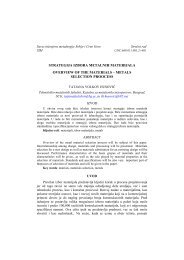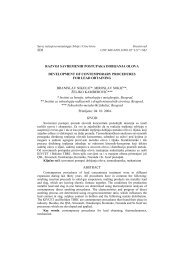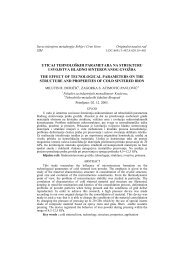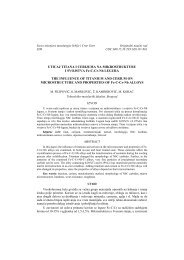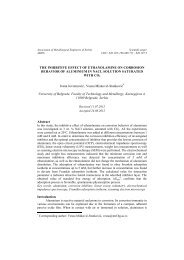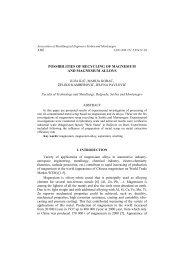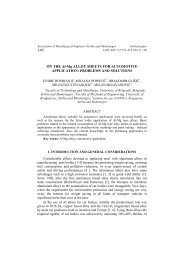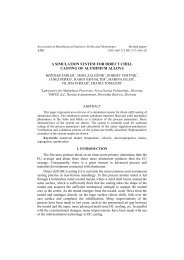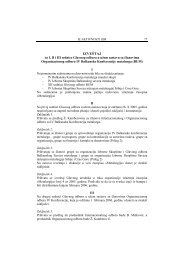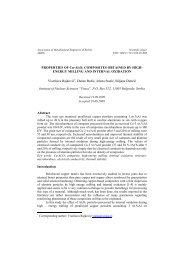STRUCTURAL CHARACTERISTICS OF SOME TERNARY Ag-In-Sn ...
STRUCTURAL CHARACTERISTICS OF SOME TERNARY Ag-In-Sn ...
STRUCTURAL CHARACTERISTICS OF SOME TERNARY Ag-In-Sn ...
You also want an ePaper? Increase the reach of your titles
YUMPU automatically turns print PDFs into web optimized ePapers that Google loves.
Association of Metallurgical Engineers of SerbiaAMESScientific paperUDC:669.225'872'6.017.3:620.182.183=20<strong>STRUCTURAL</strong> <strong>CHARACTERISTICS</strong> <strong>OF</strong> <strong>SOME</strong><strong>TERNARY</strong> <strong>Ag</strong>-<strong>In</strong>-<strong>Sn</strong> ALLOYSA. MILOSAVLJEVIĆ 1* , D. ŽIVKOVIĆ 2 , Ž. KAMBEROVIĆ 31 <strong>In</strong>stitute for Mining and Metallurgy, Zeleni bulevar 35, 19210 Bor, Serbia, 2University of Belgrade, Technical Faculty, VJ 12, 19210 Bor, Serbia, 3 University ofBelgrade, Faculty of Technology and Metallurgy, Karnegijeva 4, 11000 Beograd,Serbia, * - Corresponding author: amilosavljevic@ibb-bor.co.yuABSTRACTThe <strong>Ag</strong>-<strong>In</strong>-<strong>Sn</strong> system, as one of potential lead-free solder materials, was studied in thispaper. The investigated alloys were chosen from two sections, with molar ratio of <strong>In</strong>:<strong>Sn</strong>equal to 1:4; 1:2. DTA, XRD, SEM and microhardness investigations were used in order todetermine structural characteristics of chosen <strong>Ag</strong>-<strong>In</strong>-<strong>Sn</strong> ternary alloys.Key words: lead-free solders, <strong>Ag</strong>-<strong>In</strong>-<strong>Sn</strong>, DTA, SEM, XRD, microhardnessINTRODUCTIONLead has been widely used in all aspects of life for thousands of years. It has beenwidely used in modern society, also, particularly in microelectronics and presents thebase of majority solders up to now. But, this metal is highly toxic and therefore, it shouldbe removed from different materials, especially electonic, according to WEEE [1].So, the currently used lead-based solders in microelectronics are under way to bereplaced by lead-free alloys due to environmental and health concerns. <strong>In</strong> that purpose,various physical, chemical and mechanical properties of the candidate alloy, as well asthe economic aspect have been considered. A significant part of work is to find asubstitute for common Pb-<strong>Sn</strong> solder alloy, which has become complex and widelydiscussed. The proper alloy must have certain characteristics to satisfy:• Availability• No Toxicity• Melting temperature range• Wettability• Other process conditionsBecause of their specific properties, the candidates for replacement of Pb-<strong>Sn</strong>solder alloys are usually tin-based multicomponent alloys, for the investigated binarysystems do not satisfy some features (temperature, for example). The question aboutmelting temperature is one of the most difficult problems in the lead-free solderingtransition.
162MJoM METALURGIJA - JOURNAL <strong>OF</strong> METALLURGY, 14, (3) 2008The <strong>In</strong>-<strong>Sn</strong> and <strong>Ag</strong>-<strong>Sn</strong> investigated solder alloys [2, 3] are already in practice, butonly in exactly determined conditions. Considering these, it could be expected that <strong>Ag</strong>-<strong>In</strong>-<strong>Sn</strong> ternary system might be one among proper substitutes for common solders.Thermodynamic characteristics and phase equilibria for the <strong>Ag</strong>-<strong>In</strong>-<strong>Sn</strong> system areinvestigated from various researchers.The element activities in the <strong>Ag</strong>-<strong>In</strong>-<strong>Sn</strong> system at 1273, 1373 and 1423 K, weredeterminated by T. Miki, N. Ogawa, T.Nagasaka and M.Hino [4] (mass spectrometry),and J. Zhang [5], (mass action law, at 1423 K).Phase equilibria for the system <strong>Sn</strong>-<strong>In</strong>-X (X=<strong>Ag</strong>, Bi, Zn, Sb) was investigated by I.Ohnuma, Y. Cui, J. Liu, et al. [6]. Using Thermo Calc software, the appropriatethermodynamic database was formed, and based on that, invariant reactions of thesystem, as well as isotermal sections at 373 and 473 K, were given in the paper. Also,the phase equilibria for the <strong>Sn</strong>-<strong>Ag</strong>-<strong>In</strong> system was obtained from experimental values(DSC and optical microscopy) and optimised binary data, by X. J. Liu, Y. <strong>In</strong>ohana, etal. from Japan, and Z. Moser, W. Gasior i J. Pstrus [7], from Poland.Based on large experimental work (optical microscopy, DSC, XRD, SEM,microhardness), <strong>Ag</strong>-<strong>In</strong>-<strong>Sn</strong> alloys were investigated by G.P. Vassilev et al. [8], and theisotermal section at 553 K was obtained.As a contribution to the better knowledge of the properties of mentioned system,the results of investigation of structural characteristics of some <strong>Ag</strong>-<strong>In</strong>-<strong>Sn</strong> alloys arepresented in this paper.EXPERIMENTALTwo sections (A and B) with constant molar ratio of <strong>In</strong>:<strong>Sn</strong> (1:4; 1:2), with 5samples from each section, were chosen from the concentration range of <strong>Ag</strong>-<strong>In</strong>-<strong>Sn</strong>system. The samples were with constant volume (0,3 cm 3 ) and with compositionsgiven in Table 1.Table 1. Composition of <strong>Ag</strong>-<strong>In</strong>-<strong>Sn</strong> alloys for different sectionssection X i %at %mass<strong>Ag</strong> <strong>In</strong> <strong>Sn</strong> <strong>Ag</strong> <strong>In</strong> <strong>Sn</strong> <strong>Ag</strong> <strong>In</strong> <strong>Sn</strong>0,1 0,18 0,72 10 18 72 9,221 17,679 73,100<strong>In</strong>:<strong>Sn</strong>=0,2 0,16 0,64 20 16 64 18,615 15,850 65,5351:40,3 0,14 0,56 30 14 56 28,166 13,990 57,844A0,4 0,12 0,48 40 12 48 37,885 12,097 50,0180,5 0,1 0,4 50 10 40 47,778 10,170 42,0520,1 0,300 0,600 10 30,0 60,0 9,258 29,583 61,159<strong>In</strong>:<strong>Sn</strong>= 0,2 0,267 0,533 20 26,7 53,3 18,681 26,543 54,7761:2 0,3 0,233 0,467 30 23,3 46,7 28,254 23,356 48,390B 0,4 0,200 0,400 40 20 40 37,988 20,216 41,7960,5 0,167 0,333 50 16,6 33,3 47,936 16,939 35,125
<strong>STRUCTURAL</strong> <strong>CHARACTERISTICS</strong> <strong>OF</strong> <strong>SOME</strong> <strong>TERNARY</strong> <strong>Ag</strong>-<strong>In</strong>-<strong>Sn</strong> ALLOYS … 163Following experimental techniques were used for the investigation of structuralcharacteristics of chosen alloys: DTA, XRD, SEM and microhardness measurements.Differential-thermal analysis was carried out in an air atmosphere, with constantheating rate of 10 o /min and using Al 2 O 3 as the referent material.<strong>In</strong> order to determine the microstructure of chosen alloys, scanning electronmicroscopy (SEM) was used and the recordings were done on the JEOL-JSM T20scanning microscope. The samples were prepared using the standard procedure andpolished ones were etched with FeCl 3 solution (32 g FeCl 3 , 100 ml H 2 O 2 , 100 ml H 2 O).The identification of the phases in the alloys has been done using X-ray diffractionanalysis on Siemens D-500 apparatus, using Cu-anticathode and Ni-filters (40kV,20mA).Microhardness for the investigated alloys was determined on the PMT-3apparatus, for tin matrix and light phase separately.RESULTS AND DISCUSSIONFollowing methods of characterization were used for experimental investigation ofchosen <strong>Ag</strong>-<strong>In</strong>-<strong>Sn</strong> alloys - DTA, SEM and XRD analysis.Five samples from each section, A and B, were investigated using DTA andcharacteristic peak temperatures, determined to be in the range 213÷229 0 C, arepresented in Table 2.Table 2. Characteristic temperatures on DTA curves for investigated <strong>Ag</strong>-<strong>In</strong>-<strong>Sn</strong> alloyssectionX <strong>Ag</strong>Temperature on DTA curve, o CThe first peak The second peak The third peak0,1 219 384A<strong>In</strong>:<strong>Sn</strong>=1:40,2 229 4100,3 220 4270,4 215 4650,5 215 514B<strong>In</strong>:<strong>Sn</strong>=1:20,1 168 213 3830,2 219 4080,3 224 3860,4 219 3780,5 221 422Obtained DTA curves indicate that the beginning and the end of phasetransformation are moved to lower temperatures by the increase of indium and constantsilver content in the alloy, which is in an agreement with literature facts – small percentof indium cause lower melting temperature [9].The increase of indium content in alloy has an influence not only in decreasingmelting temperature, but also for the appearance of the peak at 168 o C for alloy B1. If
164MJoM METALURGIJA - JOURNAL <strong>OF</strong> METALLURGY, 14, (3) 2008should be noticed that temperature of this peak is close to indium melting point, so itmight be a consequence of indium dissolution in the system.The comparison of experimental DTA results with optimized values in Ref. [7] ispresented in Figures 1 and 2.Figure 1. Comparation with optimised values [7] for 10 wt% <strong>Ag</strong> vertical sectionFigure 2. Comparation with optimised values [7] for 20 wt% <strong>Ag</strong> vertical section
<strong>STRUCTURAL</strong> <strong>CHARACTERISTICS</strong> <strong>OF</strong> <strong>SOME</strong> <strong>TERNARY</strong> <strong>Ag</strong>-<strong>In</strong>-<strong>Sn</strong> ALLOYS … 165Scanning electron microscopy was used in order to determine microstructure ofthe investigated samples. Dark and light phases are noticeable in the microstructures ofchosen alloys, given in Figure 3 for the samples A2 and B4. So, microstructure of allinvestigated <strong>Ag</strong>-<strong>In</strong>-<strong>Sn</strong> alloys consists of tin matrix (dark area) with primary solutioncrystals rich on silver and indium (light area), in it. <strong>In</strong> tin matrix phases (<strong>Ag</strong> 3 <strong>Sn</strong>) ili(<strong>In</strong> 3 <strong>Sn</strong>) / (<strong>In</strong><strong>Sn</strong> 4 ) are dispersed. Besides that, the fraction of light area (primary solutioncrystals rich on silver and indium) is increased with silver content in the alloy, andwith decrease of tin content in the alloy, the fraction of tin-based phase is decreased.a) A2 (<strong>Ag</strong>20<strong>In</strong>16<strong>Sn</strong>)b) B4 (<strong>Ag</strong>40<strong>In</strong>20<strong>Sn</strong>)Figure 3. SEM microstructure of chosen alloys (Magnification x1000)The identification of different phases in ternary <strong>Ag</strong>-<strong>In</strong>-<strong>Sn</strong> alloys has been doneusing X-ray diffraction analysis. These results pointed out that all of investigated alloyshad <strong>Sn</strong> and <strong>Ag</strong> 3 <strong>Sn</strong>-based matrix with or without addition of other phases, Table 3,while X-ray difractograph for the alloy B5 is shown in Figure 4.Table 3. XRD analysis for some investigated <strong>Ag</strong>-<strong>In</strong>-<strong>Sn</strong> alloysComposition, at%XRDalloy<strong>Ag</strong> <strong>In</strong> <strong>Sn</strong> <strong>Sn</strong> <strong>Ag</strong> 3 <strong>Sn</strong> <strong>In</strong> 3 <strong>Sn</strong> <strong>In</strong><strong>Sn</strong> 4 <strong>Ag</strong> 9 <strong>In</strong> 4 <strong>Ag</strong><strong>In</strong>A2 20 16 64 + + +A3 30 14 56 + +A5 50 10 40 + +B4 40 20 40 + + + +B5 50 17 33 + + +
166MJoM METALURGIJA - JOURNAL <strong>OF</strong> METALLURGY, 14, (3) 2008intensity18001600140012001000800xxoozx - <strong>Sn</strong>o - <strong>Ag</strong> 3 <strong>Sn</strong>z - <strong>Ag</strong><strong>In</strong>600400200ozzxoxo030 40 50 602θFigure 4 - X-Ray difractograph for alloy B5 (<strong>Ag</strong>50<strong>In</strong>17<strong>Sn</strong>)The presence <strong>In</strong> 3 <strong>Sn</strong> phase in <strong>Sn</strong> matrix is typical for the alloys B1, in distinction toother alloys from section B (β-<strong>Sn</strong>, <strong>Ag</strong> 3 <strong>Sn</strong> and <strong>Ag</strong>-<strong>In</strong> phase). Concerning section A,alloys A3 and A4 have only β-<strong>Sn</strong> and <strong>Ag</strong> 3 <strong>Sn</strong> matrix, due to low content of indium.The obtained values for microhardness of <strong>Ag</strong>-<strong>In</strong>-<strong>Sn</strong> alloys (Figure 5) confirmedthe possibility of intermetallic compound formation in the microstructure (light phase).Generally, microhardness values for light phase are much higher than microhardnessfor tin matrix. These high values (100 ÷ 250 HV) indicate the presence of primarycrystals solution or intermetallic compound in the structure, which is already obtainedby results of XRD and SEM analysis.454035H µ30252055 60 65 70 75X <strong>Sn</strong>Figure 5. Microhardness for alloys in section A
<strong>STRUCTURAL</strong> <strong>CHARACTERISTICS</strong> <strong>OF</strong> <strong>SOME</strong> <strong>TERNARY</strong> <strong>Ag</strong>-<strong>In</strong>-<strong>Sn</strong> ALLOYS … 167On the other way, tin matrix has lower microhardness (20 ÷ 40 HV), and decreaseof microhardness is caused by increase of tin content in the alloy.CONCLUSIONBased on DTA curves, the information on characteristic peak temperatures ofinvestigated <strong>Ag</strong>-<strong>In</strong>-<strong>Sn</strong> alloys were obtained. Microstructure of each alloy from sectionsA and B, with constant molar ratio was determined by scanning electron microscopy.The composition of phases in the microstructure was determined by XRD analysis. Asconfirmation for previous structural investigations, the micro-hardness values forinvestigated <strong>Ag</strong>-<strong>In</strong>-<strong>Sn</strong> alloys, are presented.The indium content in alloy has great influence on the beginning and the end ofphase transformations. Considering the results, the most appropriate alloys amonginvestigated sections are the alloys from section A (<strong>In</strong>:<strong>Sn</strong>=1:4). The indium content inthese alloys is within 10 and 18 at%, which enables indium dissolution, and preventspartial alloy melting. The other reason for low content of indium is high cost price.Therefore, the alloys, which might be an alternative for the common Pb-<strong>Sn</strong>solders, are <strong>Ag</strong>-<strong>In</strong>-<strong>Sn</strong> alloys with high percent of tin, small percent of silver andindium. It is just a pre-request, having in mind a great influence of cooling rate andappropriate heat treatment on solder quality, as well as economic factors due to theindium and silver price at market, so further investigations should be carried out in thatdirection.REFERENCES[1] www.univie.ac.at/cost531[2] Korhonen T.M., Kivilahti J.K., JEM, 27(1998)149[3] T.B. Massalski, J.L. Muttay, L.H. Benett, H. Baker, Binary alloys phase diagrams,ASM, Metals Park, OH, 1990[4] Miki T., Ogava N., Nagasaka T., Hino M., Mater. Trans. 42(5)(2001)732[5] Zhang J., Calphad, 27(1)(2003)9[6] Ohnuma I., Cui Y., Liu X.J., et al., JEM, 29(2000)1113[7] Liu X.J., <strong>In</strong>ohana Y., Takaku Y., Ohnuma I., Kainuma R., Ishida K., Moser Z., GasiorW., Pstrus J., JEM, 31(2002)1139[8] Vassilev G., Dobrev E., Tedenac J.C., XXXIII Calphad Meeting Abstract PI-8,Krakow, Poland (2004); Vassilev G., Dobrev E., Tedenac J.C., Journal of Alloys andCompounds, (2005)-in print[9] M.R. Baren, <strong>In</strong>dium alloys and their engineering applications, Ed. C.E.T. White and H.Okamoto materials park, OH, ASM INTL, 1993, p. 15




